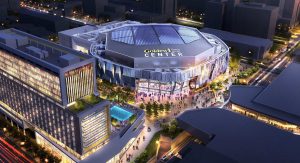Golden 1 Center Information
Located in downtown Sacramento, California, Golden 1 Center was built to be the home of NBA superstars the Sacramento Kings, and opened its doors on September 30, 2016. Leading the way as the most technologically advanced arena in the country, Golden 1 Center is on the cutting edge, from its efficient and sustainable use of solar power and renewable energy to its free, high-speed wi-fi that can handle more than 225,000 Instagram posts every second.

The arena is built for both beauty and practicality, boasting both the largest viewing screens in the NBA and a building that reflects the colors and fabric of North California, composed of sand from San Benito and rocks of Sierra limestone.
The arena also caters for guests with all the top-notch amenities you can expect from a venue that prides itself on attention to detail, and offers a whole host of dining experiences and sensational farm to fork foods.
Golden 1 Center is a revolutionary venue that combines cutting-edge green technology with a prime downtown location, offering unforgettable experiences. Our visitor guide to Golden 1 Center in Sacramento helps guests navigate the arena, discover must-see features, and enjoy Sacramento’s unique character.
Location and Setting
Golden 1 Center occupies a prominent position in downtown Sacramento’s revitalized entertainment district. The arena sits in the Downtown Commons (DoCo) development, transforming what was once the site of the old K Street Mall into a thriving hub of activity. This central location places the venue less than a mile from the California State Capitol and within walking distance of Old Sacramento, the Sacramento Convention Center, and numerous hotels and restaurants.
The arena’s address at 500 David J. Stern Walk honors the former NBA commissioner whose efforts proved instrumental in keeping the Sacramento Kings in California’s capital city.
Architectural Design and Sustainability
The building’s architectural design pushes boundaries while honoring Sacramento’s character. Designed by AECOM Architects, the arena features a striking glass exterior that creates transparency between the venue and the surrounding cityscape. The structure’s most distinctive feature is five-story aircraft-hangar-style doors that open to allow natural ventilation from the cooling Delta breeze, reducing energy consumption while connecting the indoor space with the outdoor environment.
Environmental innovation defines Golden 1 Center’s identity. The arena achieved LEED Platinum Certification, which is the highest level of recognition for sustainable building practices. A massive rooftop solar array produces significant clean energy, contributing to the venue’s status as the first carbon-neutral and grid-neutral arena in professional basketball.
The building incorporates numerous green features, including advanced HVAC systems, LED lighting throughout the facility, water conservation measures, sustainable construction materials, and drought-resistant landscaping.
Technology and Innovation
Golden 1 Center earned recognition as the “most connected” arena in the world when it opened. The venue invested heavily in Wi-Fi and cellular infrastructure, enabling tens of thousands of simultaneous connections without performance degradation. Free Wi-Fi extends throughout the building and into the surrounding plaza, allowing guests to stream video, share photos, and access interactive features seamlessly.
The center-hung scoreboard dominates the arena with its massive 4K displays measuring 84 feet in length, making it the second-largest in the NBA. Corner auxiliary boards ensure guests never miss action regardless of their seating location. The video display quality and size set new standards for arena entertainment technology.
The venue’s mobile-first approach revolutionizes the guest experience. The official Golden 1 Center app provides mobile ticketing, interactive venue maps, real-time parking availability, food and beverage ordering for in-seat delivery, and instant replays viewable from any seat.
The “Light the Beam” Tradition
In 2022, Golden 1 Center added one of professional sports’ most distinctive victory celebrations. Following each Sacramento Kings home win, six purple lasers using a total of 1,800 watts illuminate the sky, visible throughout downtown Sacramento and beyond. This “Light the Beam” tradition became a rallying cry during the Kings’ successful 2022 to 2023 season when the team secured its first playoff berth in 16 years.
The Story Behind Sacramento’s Crown Jewel
The history and design of the Golden 1 Center arena showcase how a state-of-the-art arena can drive economic growth, reshape downtown, and reconnect communities. Its development transformed not only a single city block but an entire district, demonstrating that sports venues can become powerful catalysts for urban renewal when guided by thoughtful planning and sustainable architecture.
Origins and Development
Golden 1 Center’s story begins with the Sacramento Kings’ long-term future in California’s capital. For years, the team played at ARCO Arena (later Sleep Train Arena), located in North Natomas, which is a distance from downtown. The aging facility lacked modern amenities and revenue-generating capabilities, creating financial challenges that threatened the franchise’s viability.
Relocation threats emerged in the early 2010s. The Seattle group led by investor Chris Hansen attempted to purchase the Kings and move them to Washington State.
Sacramento’s civic leaders, business community, and passionate fans rallied to save the team. This effort culminated in a complex financing plan involving the City of Sacramento, the Kings’ ownership group led by Vivek Ranadivé, and AEG (Anschutz Entertainment Group).
Construction and Opening
Ground broke on the downtown site in 2014 following the demolition of the old Downtown Plaza shopping mall. The location in the heart of Sacramento represented a deliberate choice to catalyze downtown revitalization. AECOM led the arena design, integrating advanced sustainability features and creating a structure intended to serve as a civic landmark.
Construction prioritized local involvement. Contractors hired Sacramento-area workers, and suppliers sourced materials from Northern California when possible, extending the economic benefits as far as possible.
Golden 1 Center officially opened on October 4, 2016, with a Paul McCartney concert. The Kings played their first home game on October 27, 2016, against the San Antonio Spurs. The opening symbolized Sacramento’s transformation and the community’s commitment to supporting the Kings franchise.
The Impact on Downtown Sacramento
The arena immediately spurred additional development in the surrounding areas. The Downtown Commons (DoCo) entertainment district emerged around the venue, featuring restaurants, bars, shops, and a luxury hotel. The Kimpton Sawyer Hotel opened directly adjacent to Golden 1 Center, offering guests accommodations steps from arena entrances.
Residential development accelerated in nearby neighborhoods. Young professionals and families moved to areas that previously had lower visibility but were now filled with the energy and amenities of the growing entertainment district. Property values increased, and small businesses flourished to serve the expanding population.
The economic impact extended beyond the initial construction phase. Approximately 2,000 jobs connect to Golden 1 Center operations, including arena staff, hospitality workers, retail employees, and supporting service providers. Annual visitor spending continues to boost downtown businesses and the regional economy.
Notable Events
Beyond regular Kings games and concerts, Golden 1 Center has hosted several major events:
- NCAA Tournament Games (2017 and 2023), bringing national visibility and college basketball excitement to Sacramento
- WWE events, showcasing the arena’s versatility for entertainment programming
- UFC events, demonstrating its ability to host large-scale sporting productions
- California State High School Basketball Championships, allowing young athletes to compete in a professional-level venue
- California State Assembly sessions during the COVID-19 pandemic, making use of the arena’s volume for safe distancing during critical governance
